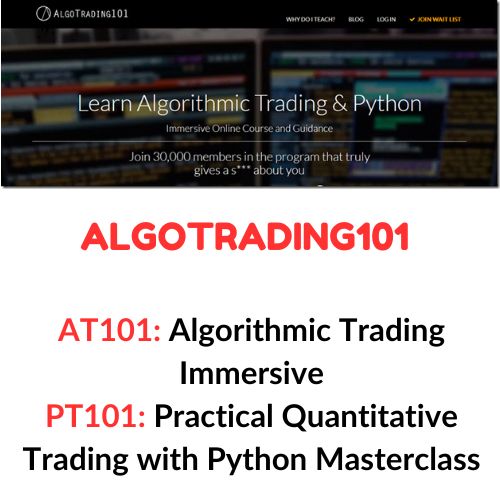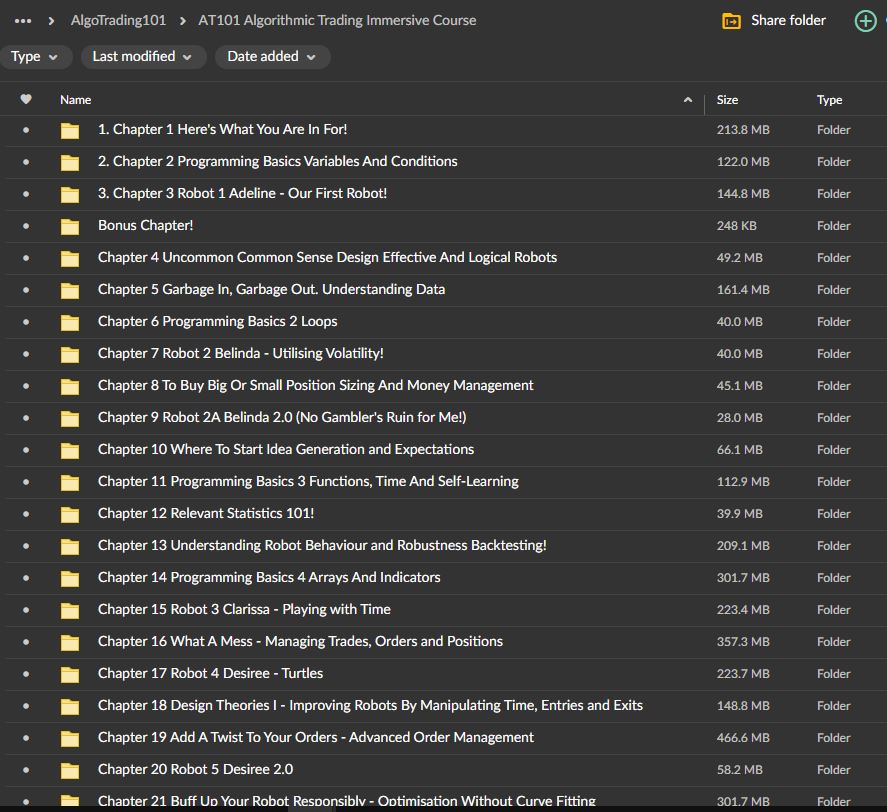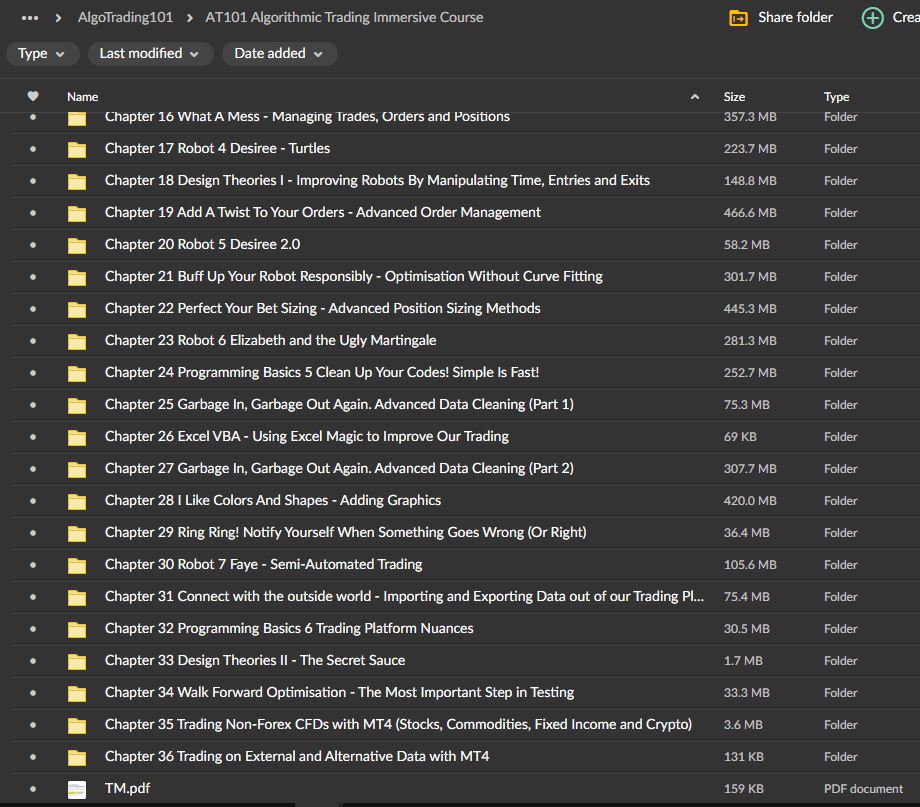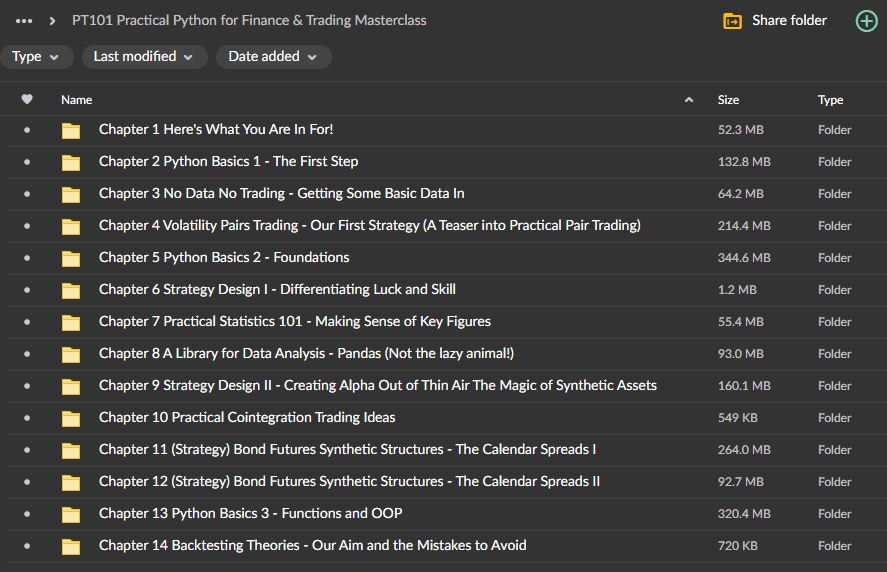AlgoTrading101 Courses Download
AlgoTrading101 Courses | Size: 7.05 GB
About Courses:
AlgoTrading101 Course Syllabus
AlgoTrading101 consists of 2 main courses:
- AT101: Algorithmic Trading Immersive Course
- PT101: Practical Quantitative Trading with Python Masterclass
AT101 focuses on the fundamentals of trading strategy design, testing and execution.
PT101 focuses on modern and more advanced strategies such as:
- Obscure markets like Canadian bond STIR futures
- Multi-asset strategies
- Alternative data
- Web scraping
- Machine learning
AT101: Algorithmic Trading Immersive Course
Chapter list (along with learning objectives for each chapter)
AT101: Algorithmic Trading Immersive Course
Chapter list (along with learning objectives for each chapter)
- Here’s What You Are In For!
- What is an Algo Trading Robot, its key traits and code structure
- What makes a successful Algo Trader
- How to set up and navigate your infrastructure/coding software
- Programming Basics 1: Variables and Conditional
- Basics of our coding language (MQL4)
- Syntax, Variables, Operations and Conditional Expressions
- Robot 1: Adeline – Our First Robot!
- Background to Forex markets, chart reading, basic indicators
- Coding Adeline together
- Testing Adeline using past data
- Brief look at modelling quality
- Uncommon Common Sense. Design Effective And Logical Robots
- Overview of our Strategy Development Guide
- Preliminary Research
- Backtesting
- Optimisation
- Live Execution
- Pros and Cons of an Algo Trading Robot
- Mathematical Expectations of our robots’ performance
- Overview of our Strategy Development Guide
- Garbage In, Garbage Out. Understanding Data
- Data Sources and Storage
- A look at the importance of data cleanliness
- Cleaning data (basic)
- Bad ticks, inaccurate testing and market tricksters
- Programming Basics 2: Loops
- Learning how to code loops
- Practice Exercises for Loops
- Robot 2: Belinda – Utilising Volatility!
- Our first measure of volatility (ATR)
- Introducing Belinda, the improved version of Adeline
- Coding and testing Belinda
- To Buy Big or Small? Position Sizing and Money Management
- Understanding trade/bet size (how much to trade per position) using a coin flip game
- Designing a bet sizing algorithm based on account size
- Coding our bet sizing algorithm
- Robot 2A: Belinda Upgraded (No Gambler’s Ruin for Me!)
- Implementing our bet sizing algorithm in Belinda
- Where To Start? Idea Generation and Expectations
- Setting expectations for our robots based on our resources, personality, skill set, lifestyle and goals
- Understand the essence of a trading idea – Proxies and Relationships
- Sources of trading ideas
- A look at the different types of strategies
- Grading ideas – Introducing our framework for vetting ideas
- How to fight against big hedge funds
- Programming Basics 3: Functions, Time and Self-Learning
- Learn to learn programming
- Code errors and debugging
- Coding Functions
- Practice Exercises for Functions
- Relevant Statistics 101!
- Statistical significance and Law of Large numbers and their role in robot testing
- Deriving suitable minimum sample size for our backtests
- Understanding Robot Behaviour and Robustness: Backtesting!
- Ensuring code accuracy
- Types of market condition
- Testing for Robustness
- Period Robustness
- Timeframe Robustness
- Seasonal Robustness
- Instrument Robustness
- Testing our robots through intended and unintended periods
- Stress testing our robots through black swans
- The butterfly Effect – Backtest bias via start point selection
- Grading the performance of our robots
- Programming Basics 4: Arrays And Indicators
- A look at our mentality towards Indicators
- Math behind Indicators
- Coding Arrays and Indicators
- Robot 3: Clarissa – Playing with Time
- Understanding the Datetime data type
- Coding rules revolving date and time manipulation
- Introducing and coding Clarissa – our robot that uses time entries
- What A Mess – Managing Trades, Orders and Positions
- Order limitations by your brokers
- Coding our customised order function
- Multiple order management
- Modelling transaction cost, spreads and slippage
- Robot 4: Desiree – Trade like the Turtles
- The history of the Turtle Traders
- Introducing and coding a simplified turtle strategy
- Design Theories I – Improving Robots By Manipulating Time, Entries and Exits
- Profitability in different timeframes
- Deriving optimal stop loss levels
- Comparing the importance of entries vs exits
- Analysing asymmetrical long and short rules
- Add A Twist To Your Orders – Advanced Order Management
- Breakeven and trailing stops
- Hiding from your broker – Creating virtual stops and take profit orders
- Robot 5: Desiree 2.0
- Buff Up Your Robot Responsibly – Optimisation Without Curve Fitting
- Objective Functions, Robustness and Curve Fitting
- 10 Ways to minimise curve fitting (overfitting)
- Degrees of Freedom
- Parameter Robustness
- In and out-of-sample testing
- Optimisation Evaluation
- Perfect Your Bet Sizing – Advanced Position Sizing Methods
- Relationship between sizing and trading frequency
- Gearing up and down with volatility
- Impossible Trinity of Sizing – Relationship between Leverage, % Risked and Stop Loss
- First Principles of sizing – Building customised sizing algorithms
- Other types of sizing – Kelly Criterion, Martingales and Anti-Martingales
- Robot 6: Elizabeth
- Programming Basics 5: Clean Up Your Codes! Simple Is Fast!
- Clean and robust coding
- MT4 Global Variables
- MQL4 Libraries
- Garbage In, Garbage Out Again. Advanced Data Cleaning (Part 1)
- Creating custom timeframes
- Clean data, biased output
- Excel VBA – Using Excel Magic to Improve our Trading
- Excel trading game
- Syntax
- Conditional statements
- Loops
- Garbage In, Garbage Out Again. Advanced Data Cleaning (Part 2)
- Data time zone manipulation
- Defining “clean enough” data
- Scanning for errors
- Advanced data cleaning methodologies
- I Like Colors And Shapes – Adding Graphics
- Creating a Dashboard: Graphics and Labels
- Creating trendlines and levels
- Ring Ring! Notify Yourself When Something Goes Wrong (Or Right)
- Coding smartphone notifications
- Notify yourself during trade or price events
- Robot 7: Faye – Semi-Automated Trading
- Connect with the outside world – Importing and Exporting Data out of our Trading Platform
- Read and write information to Excel
- Build a spread logger
- Programming Basics 6: Trading Platform Nuances
- Perfecting the little coding details
- Understanding trading and backtesting nuances
- Design Theories II – The “Secret Sauce”
- Prudence-Behavioural Framework
- Alpha 1: Data
- Alpha 2: Global Macro
- Alpha 3: High-Frequency Trading
- Alpha 4: Market Microstructure
- Hybrid Model – Semi-Algorithmic Trading
- 5 Realities of Algorithmic Trading
- Crowd Behaviour – Outwitting the Masses
- Walking Forward – Advanced Optimisation
- Walk Forward Optimisation
- Performance patterns, consistency and seasonality
- 3D Parameter space evaluation
- Trading CFDs
- Looking Outwards – Trading On External Info and Alternative Data
- Trading using volume
- Feeding external data into MT4
- Trade on external events
- Robot 8: Gwen
- Cash Is King! – Running Robots With Real Money
- Paper versus Live trading
- Minimum Capital Determination
- Broker Selection
- Virtual Private Servers
- Downtime Prevention Protocol
- Hedging issues
- Strategy Monitor – Updating our robots regularly
- Live walk-forward optimisation
- Investor Marketplace
- Watch Her Well – Monitoring Your Robot(s)
- Operational Risk Management
- Monitoring our robots
- When to manually intervene
- Reviewing performance
- Understanding Trading Psychology – Emotions during drawdowns
PT101: Practical Quantitative Trading with Python Masterclass
(In progress, we are still adding content)
Practical Strategies for Modern Markets
Basic Python and Test Strategies
- Just enough Python to get you started (we will learn more advanced Python techniques in the later part of the course)
- Designing a simple pair trading test strategy to whet your appetite and give you an rough sense of what to expect
Cointegration (Mean reversion: When A and B moves apart, we bet they will revert) (WE ARE HERE NOW)
- (Concept) Synthetic assets (ranging assets that are made by combining different assets)
- (Strategy) Bond futures calendar spreads and structures (creating ranging assets using bond futures)
- (Strategy) Market making using a proxy asset (entering and exit trades at the bid and ask prices)
- (Strategy) Statistical Arbitrage. Trading hundreds of stocks in a mean reversion manner.
Sentiment Analysis and Web API (Collect data from websites via special “links”)
- (Concept) Use Web API to collect data (eg. Google trends to analyse search traffic)
- (Strategy) Scour tons of stocks to see which stocks have sudden increase in search traffic volume
Alternative Data (Non-price data like Credit card, Location data etc)
- (Strategy) Use paid alternative data from vendors to analyse stocks
- (Strategy) Create your own special index by combining different alternative data (eg. combine retail receipts + foot traffic + search traffic to create a special index to predict retail stock prices. Live eg: MongoDB tracker, Crypto Tracker)
- (Strategy) Creatively find data on websites and scrape them to predict market moves
Correlation (If A moves, trade B)
- (Concept) Understand the statistical methods to test correlations
- (Strategy) Use Google search data, job listings and other scrapped data to predict stock and spread movements
- (Strategy) Use synthetic assets to predict other synthetic assets
Sentiment and Text analysis (Machine Learning)
- (Concept) Evaluate the sentiment of a particular phrase, sentence, paragraph or article
- (Strategy) Analyse tons of news articles in different language to find out the market sentiment towards an asset
Sales Page: Link
Join us on Telegram: https://t.me/thecoursepedia
More courses: https://thecoursepedia.com/shop/












Reviews
There are no reviews yet.